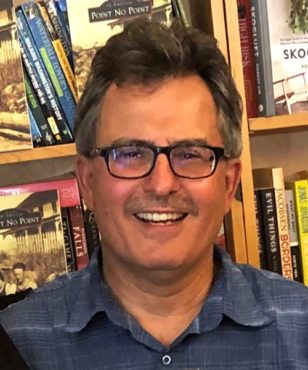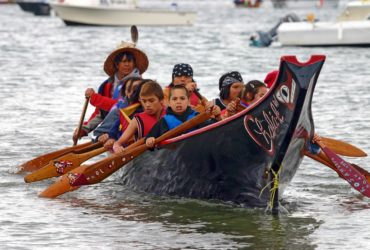
Port Gamble S’Klallam master fish cook Benji Ives tends his barbecued salmon and his clambake pit with as much care as Tom Douglas might put into his own applewood-smoked black cod or Hama Hama purple clams.
But you won’t find hot mustard and sesame on Ives’ salmon, or bacon, leeks and malt vinegar croutons with his shellfish. What you’ll get is food prepared using smoking and steaming techniques that have been passed down through generations — techniques that allow the flavor of the salmon and shellfish to speak for themselves.

“I like to say that our recipe is thousands of years old,” Ives said.
Ives’ family has been cooking at important community gatherings for several generations — at the First Salmon Ceremony, when the first salmon of the year is honored; at celebrations and funerals; and at the Canoe Journey, the annual gathering of Northwest Native canoe cultures.
Ives calls cooking salmon and shellfish “beautiful artwork.” And indeed it is.
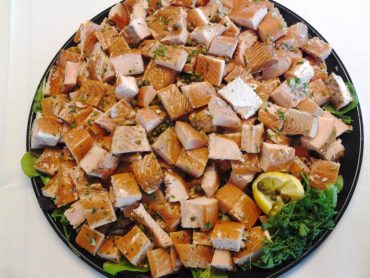
Experiencing indigenous cuisine is a great way to learn about the First Cultures of the Evergreen State — and gain a deeper appreciation for what the Salish Sea provides. The Canoe Journey, the annual gathering of Northwest Native canoe cultures, is a great place to start.
“We like to share with our neighbors,” said Wayne George, the Suquamish Tribe’s lead fish cook (and general manager of the tribe). “Caring and sharing is part of our heritage and culture.”
Each meal shared reminds people of what’s at stake. “When the tide is out, the table is set,” the Coast Salish adage states. But that’s long been threatened. Salmon must navigate a gauntlet of pollution, predators and degraded habitat to reach adulthood and continue the cycle of life. Native shellfish populations are struggling to rebound from years of overharvesting, displacement by cultivation of nonnative species, and stormwater runoff and failing septic systems that contaminated beds.
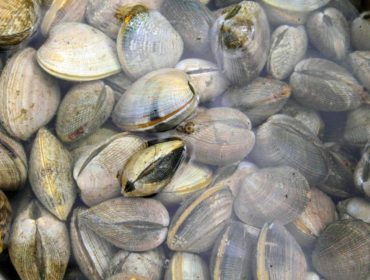
“Most people who come to the celebration have that in mind — that we have to take better care of what we have,” George said.
This summer, Northwest Native canoes will make their way to the shores of the Puyallup Tribe, visiting indigenous territories along the way for reunion and sharing of songs, dances and foods. Canoes will stop at Port Gamble S’Klallam’s Point Julia on July 24; and in Suquamish, on the shores below the House of Awakened Culture, on July 25. Suquamish is the second-to-last stop on the 2018 Canoe Journey, and approximately 80 canoes are expected to land there, Suquamish Tribe communications director April Leigh said.
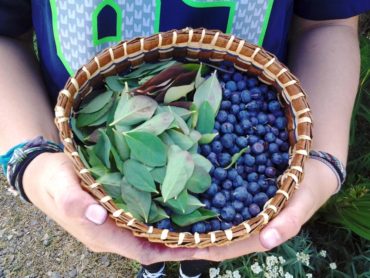
The Canoe Journey Celebrations
Here’s what you can expect at Point Julia and Suquamish: First, you may hear a song from across the water as each canoe draws closer. Then, each canoe, carved and painted in a style reflective of its Native nation, will arrive and the skipper will stand and ask in his or her Native language for permission to come ashore.
Each arriving canoe may be greeted with a song — a song often as old as the place — by representatives of the host nation, many of whom will wear articles of clothing that are as beautiful as they are functional: hats, headbands and vests woven of naturally rain-repellent cedar fiber; skirts woven of cedar and mountain goat wool; and shawls with elaborate, embroidered designs. In the evening, representatives of each indigenous nation will present songs, dances and gifts in the longhouse.
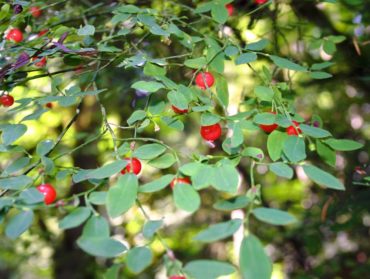 The air will be heavy with the alder-smoke scent of grilled salmon. Clams and oysters will be steaming in the clambake pit. There will be Dungeness crab, and possibly geoduck chowder and deer or elk stew.
The air will be heavy with the alder-smoke scent of grilled salmon. Clams and oysters will be steaming in the clambake pit. There will be Dungeness crab, and possibly geoduck chowder and deer or elk stew.
Depending on where you are on the Canoe Journey, you might enjoy elk or venison stew with wild nodding onions, wild carrots, wapato or camas. Head north into Kwagiulth territory, and you might dip your food into nutrient-rich ooligan oil or enjoy the smelt it comes from — boiled, baked or grilled, dried, salted or smoked. The Heiltsuk First Nation served black cod, halibut, salmon and herring roe on kelp to its guests during the 2014 Canoe Journey.
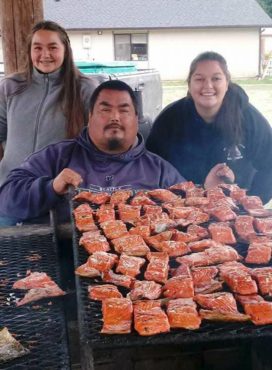
These foods are no luxury. Foods that sustained the First Peoples since the beginning of time hold innumerable proven health benefits: Blueberries and huckleberries are rich in vitamins and antioxidants; crab meat is rich in essential fats and minerals; kelp is rich in minerals and vitamins A, B1, B2, C, D and E, and has the highest natural concentration of calcium of any food; salmon is rich in Omega-3 fatty acids that play an important role in brain function and cardiovascular health; and venison is rich in iron and protein.
Cooking the Old-Fashioned Way
During the Canoe Journey, breathe deeply and take it all in: You’re experiencing the same sounds and smells from hundreds of years ago. And in the preparation of the meal, not much has changed.
The beauty in the delicious salmon you’ll experience at S’Klallam or Suquamish gatherings is the simplicity in how it’s cooked: no seasoning, marinades or glazes that only mask the salmon’s natural flavor.
“We cook salmon the old-fashioned way — alder smoke, salt and pepper,” George said.

The Port Gamble S’Klallam Tribe is known for its clambakes at Point Julia. Ives said preparing a meal for a community event takes 72 hours from start to finish.
First, harvested clams — butters, cockles, manilas — are kept in cool, filtered water for 36 hours to allow time for them to naturally purge grit and sand. Water temperature and salinity are regulated.
Ives and his family collect river-washed rocks from streams for use in the clambake pit. Alder is used for baking clams because it burns hot; a proper fire will give off heat felt in a 6- to 8-foot radius. Ives strips bark off the alder used in smoking salmon because the bark can give salmon a bitter taste, he said.
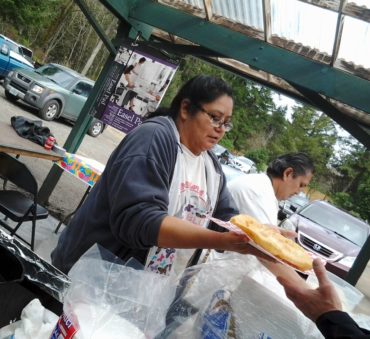
Ives plans a pound to pound-and-a-half of shellfish per person. “Three to four cockles, five to six manilas, an oyster and a chunk of crab, and you’ve got a feast,” he said.
At Suquamish, George is responsible for estimating how much fish is needed (one sockeye salmon will feed 10 guests, he said), and acquiring, cleaning and cooking the fish. He said the Suquamish Tribe has fed as many as 10,000 guests during the Canoe Journey. That’s roughly 1,000 sockeye — quite a gift, considering many Native fisheries have declined up to 80 percent, according to the Northwest Indian Fisheries Commission.
Water, Flour and Love
Expect to see frybread at local Native events. This food, born out of necessity in the mid-1800s, is an indigenous staple that can be enjoyed several ways. And, like salmon cooks, all frybread cooks are not the same.
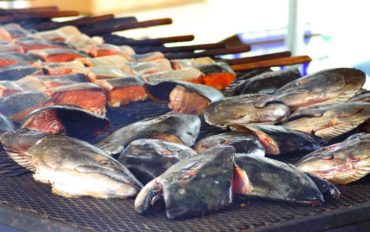
To John Price, son of a Navajo father and S’Klallam mother, cooking frybread is almost a meditative exercise.
“There are a lot of memories,” he said. “Many of the Navajo words we know we learned while making frybread.”
Price’s father directed his children in the Navajo language regarding ingredients and preparation. Price is hesitant to reveal too much of his family’s secret, allowing only that the chief ingredients are flour, baking powder, cooking oil, salt and water — “and love.”
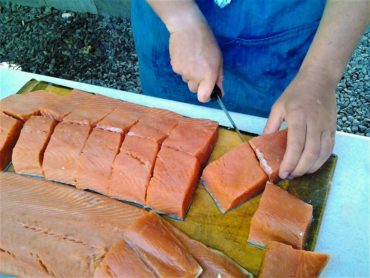
What makes one cook’s frybread different than another’s is how much of each ingredient is used, the water temperature when making the dough, how much the dough is kneaded, and the heat when cooking. “It’s all in the technique,” Price said.
Frybread, too, tells a story. It originated in 1864 during the U.S. government’s forced relocation of the Navajo people to Bosque Redondo, New Mexico. Removed from lands and foods that had sustained them for millennia — game, beans, corn, squash — the people had to create a food from the rations they were given by the U.S. government.
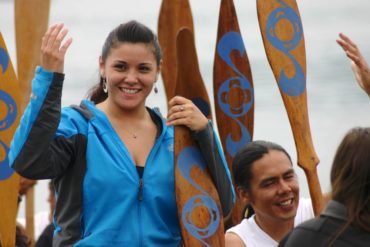
Rations of meat were often rancid and the vegetables bad, Price said. The people took fat from meat that wasn’t spoiled and, with their flour, lard, salt and sugar rations, created a fried bread that was — although high calorie — sweet, filling and versatile.
This story was repeated in other places where the experience was similar: displacement, traditional diets replaced by government rations, promises of money that sometimes never came.
Frybread is enjoyed different ways in different regions. In the Northwest, it’s commonly eaten with butter and jam; in the Southwest, with salt and green chile; in Navajo country, with honey or roasted hatch chile. Price recommends cutting your frybread into pieces “like a pizza,” and trying each piece a different way.
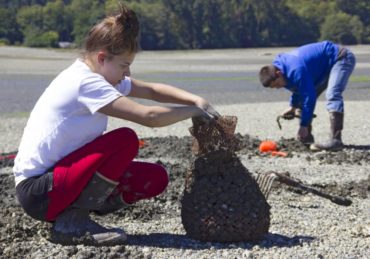
But, as with all foods, practice moderation: Each piece of frybread is the size of a paper plate and packs about 700 calories and 27 grams of fat, according to the U.S. Department of Agriculture.
So, enjoy that frybread. But if you’re still hungry later, eat a cockle.
Learn More About Native Culture
The Suquamish Clearwater Casino Resort is a showcase of Coast Salish art. Suspended above the hotel lobby is a cedar canoe and reef net set carved by Suquamish master artist Ed Carriere.
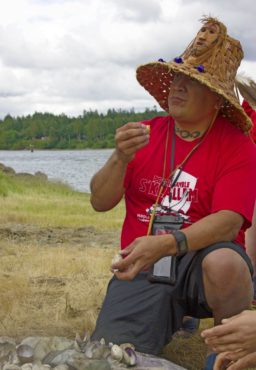
In walkable Suquamish Village, visit Old Man House Park, the site of what was once the largest winter longhouse in the Salish Sea; the Suquamish Museum; Chief Seattle’s gravesite at the Suquamish Cemetery; the Suquamish Veterans Memorial, featuring Skokomish artist Andrea Wilbur-Sigo’s house posts depicting Chief Seattle and Chief Kitsap; and the House of Awakened Culture, a community building overlooking Port Madison Bay.
In Little Boston, The Point Hotel features S’Klallam artist Brian Perry’s three-story steel sculpture of two paddles, titled “Paddles Up,” and the courtyard is ringed with cedar honor poles and story poles carved by noted Northwest Native artists. The courtyard floor features a pattern, also by Perry, representing a Coast Salish spindle whorl. Coast Salish art is featured throughout the hotel and casino.
At the government complex in Little Boston, numerous poles honor S’Klallam’s military veterans or tell the story of the S’Klallam culture of welcome.
Visit Point No Point, on Admiralty Inlet at the entrance to Puget Sound, which in the time of the grandparents’ grandparents was a village led by Challacum, a Suquamish leader. A monument identifies the point as the site of the signing of a treaty by representatives of the U.S., S’Klallam, Chimacum and Twana peoples, making land west of the area, including much of the Olympic Peninsula, available for non-Native settlement.
Richard Walker is a journalist, author and poet of Yaqui ancestry living in Poulsbo.




